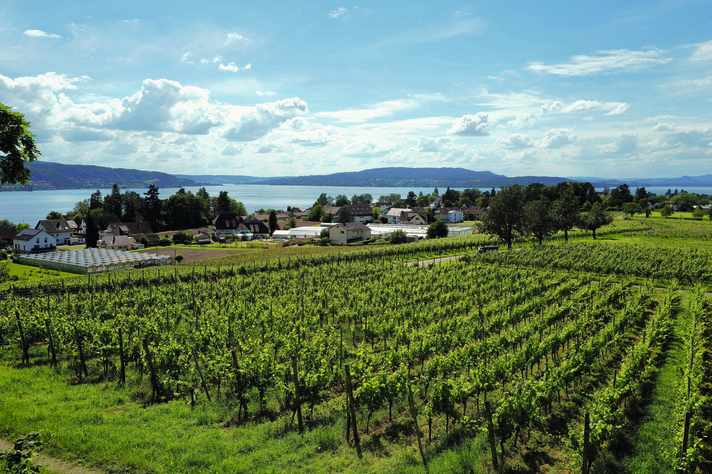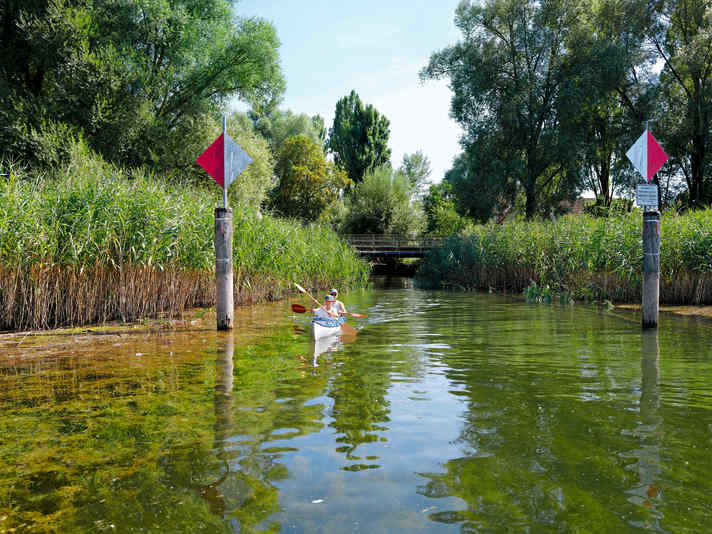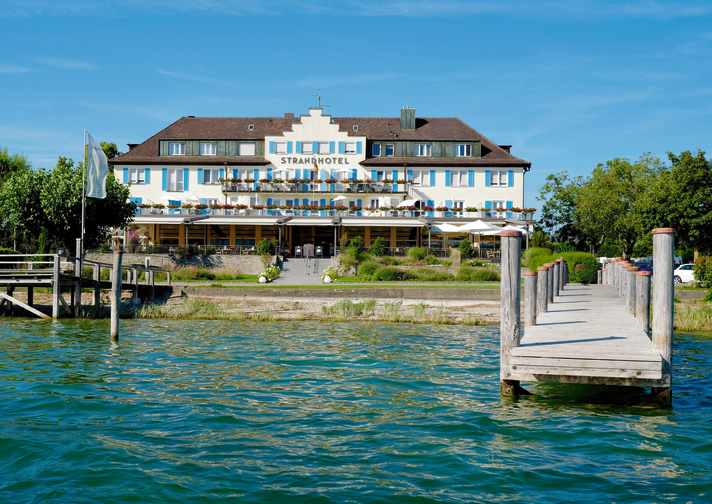





Text by Heinz Klausmann
Admittedly, it was a bit late. And of course it was more of a joke when the topic of the hybrid-powered motorboat came up at the class reunion on the Lower Rhine. But curiosity was aroused. Now guests on the island of Reichenau are amazed at the sight of the boat on the beach in front of the house. It is not a yacht in the traditional sense, lying there peacefully in the water. It is a traditional fishing gondola from the Reichenau boatyard Beck & Söhne. In addition to the powerful 25 hp outboard motor, it has two solid spruce rudder blades. "Dual drive 1.0". Suitable for a boat with a length of 5.75 metres and a width of 1.50 metres.
Panoramic view of the Reichenau
The plan is to circumnavigate the island. But first we get an overview. From the viewing terrace on the Hochwart, the highest point on the island, you have a good view of the different parts of the 62 square kilometre, highly indented lake. To the north is the Gnadensee with the Reichenau marina, which is very well protected even in strong westerly winds. On the northern shore of the lake you can recognise Allensbach with its typical Untersee buoy fields.
In a north-westerly direction, Lake Zell stretches as far as Radolfzell, the third largest town on Lake Constance. The Mettnau peninsula separates Lake Zell from the Markelfinger Winkel to the north, a tranquil nature reserve. To the south-west, you can see Lake Rhine from the Hochwart. Between the towering Höri peninsula to the north and the Swiss shore to the south with the Seerücken ridge in the background, the lake tapers off until just before Stein am Rhein. From there, its waters make their long journey in the High Rhine towards the North Sea. We enjoy the view to the south of the Swiss canton of Thurgau with the towns of Berlingen, Mannenbach and Ermatingen from the terrace of the Hochwart art gallery. Built as a teahouse and "belvedere", the building has towered over the hill since 1833. In fine weather, artisan Juliane Epp serves her guests homemade cakes alongside tea and coffee. A place to linger.

Island wine at its finest
To the east, the view extends over extensive vineyards to the Wollmatinger Ried nature reserve. In the distance, you can just make out Gottlieben with the naked eye. The first village on Untersee lies on the border of the Seerhein. The Upper Lake, which is almost eight times the size of Lake Constance, squeezes its waters through this four-kilometre-long river-like part of the lake before pouring into the much shallower Lower Lake. It's a good idea to taste the new Solaris and Muscaris grape varieties at the Moser winery on the southern shore on the way back from Hochwart. The young winegrower endeavours to adapt these fungus-resistant grape varieties to the local climate and soil conditions through sustainable cultivation. The results are impressive.
Fortunately, the water is at a normal level. In June 2024, fire brigades and disaster control teams were in constant action at the Constance water level of 505 centimetres. In Switzerland, parts of the villages near the lake were under water. On the island of Reichenau, sections of the lakeside path were closed. At the Herrenbrücke marina on the northern shore of the island, the lake was overflowing. Wooden structures provided access to the jetties.
Read more about the 2024 Lake Constance floods here:
This year, however, things looked very different:
Same rules for all
Supply the tarpaulin and tarpaulin holder, unlock the stern stowage box and operate the main switch. Lower the outboard motor. That's how easy it is to get the gondola ready for sailing. Cast off. But beware, the Lake Constance Navigation Regulations (BSO) apply to fishing gondolas just as much as to large yachts! On the whole of Lake Constance, motor-powered vessels must keep a minimum distance of 300 metres from the shore or reed beds in front of the shore. To minimise the impact of waves, when mooring, casting off and anchoring, the destination must be approached by the shortest route and not faster than 10 km/h. Nature conservation is a top priority here.
You can find more information about right of way rules on Lake Constance in this article:
Caribbean feeling on Lake Constance
For a long time to come, the shimmering Caribbean-coloured bottom of the slope below us is visible through the crystal-clear water. At the point where it merges into the Wysse, there is sufficient distance to the shore. When the water is calm, there is time for the necessary safety briefing. The life jackets are in the stern stowage box, as is the bailer. It is used to discharge water from the inside of the boat if there is no bilge pump. But don't worry: "Thanks to the design with three separate watertight air chambers (two sea tanks and a double floor at the front), the boat is unsinkable with intact air chambers and a predetermined load condition," guarantees the shipyard. This creates confidence. The storage compartments in the bow and stern become immaculate seating areas and the boat floor becomes a sunbathing area. The variably adjustable seat board serves as a "privileged vantage point" for sunsets and picnics on board.
From insider tip to booming gastronomy
It continues - for the time being without a motor and only by hand. "Dual drive 1.0"! Ecologically valuable. In calm conditions, the gondola quickly approaches the northern shore of the Reichenau. A flat jetty soon emerges from the reeds. Smaller boats land there. A few metres away, tourists crowd in front of the fish bistro "Bei Riebels". TikTok and Instagram have paved the way from an insider tip to a booming restaurant. However, a visit to the traditional fish shop is still worthwhile. On offer are mainly local specialities such as whitefish, char and Kretzer. Professional fishermen set their nets on the lake every day. However, high water quality and the associated lack of nutrients as well as the proliferation of the protected cormorant have been affecting catch quotas for years. Behind the jetty, the Basilica of St. George with its famous murals in the Oberzell district shines above a wide belt of reeds. Red-white-red buoys mark the western edge of the Wollmatinger Ried nature reserve. Passage prohibited!

To the south, we recognise the Bruckgraben, the entrance to which is marked by red and white signs and which we now approach slowly. A causeway built in 1838 on the initiative of Napoleon III leads from the mainland to the island. Shortly before it, a statue of the patron saint Pirmin welcomes visitors to the island. Only vessels with a shallow draught and low superstructure can pass through the narrow passage, which is only ten metres wide. When the water level is high, it's time to keep your heads down! The white triangles of the red and white signs at the canal exit reflect in the dark and show Gnadensee residents the way safely at night.
Villas and shipyard visit on the southern shore of Reichenau
The view opens up to the Swiss shore. Mute swans enliven the expansive area between the Wollmatinger Ried to the left and the village of Ermatingen to the right. The boat glides leisurely along villa-like estates with gardens sloping down to the lake on the southern shore of Reichenau towards the west. We meet Rolf Winterhalter at the Beck boatyard. He is the fourth generation to run the business, which was founded in 1897. All boat hulls can be made of wood or glass fibre polyester using the hand lay-up method. It's exciting to see how high-quality oars for future fishing gondolas are made by hand from raw spruce planks.
The best spots to linger
The tour continues to the Reichenau landing stage. This is where the ships of the "White Fleet" of the Bodensee-Schiffsbetriebe (BSB) dock on their way from Kreuzlingen to Schaffhausen and back. In the summer months, the solar ferry Insel Reichenau connects Reichenau and Mannenbach opposite with its Napoleon Museum. The neighbouring motorboat harbour has a few berths for guests. When the water level is high, yachts can also find a berth for the day at the jetty of the traditional "Strandhotel Löchnerhaus", just a stone's throw away.
It is only suitable for overnight stays when the weather is absolutely stable. Such considerations leave a gondola cold. The flat-bottomed boat can easily be pulled onto the pebble beach outside the bathing area. A line to the shore prevents the boat from taking on water unintentionally due to the waves from the course boats. We soon find ourselves on the elegant hotel terrace enjoying a bowl of strawberries with vanilla ice cream. From here, we have a south-westerly view of Untersee, which narrows between the Höri peninsula and the Swiss shore. What a view!

Back on the lake, the south-west tip of the island is soon rounded. As the wind picks up, a few surfers and kiters liven up the water in front of the Sandseele campsite. In stormy weather, this is one of the favourite spots on Untersee. On calm days, a number of yachts anchor directly in front of the restaurant on the beach with its marvellous view of Lake Zell. The sunsets here are spectacular. We seek peace and quiet in the small bay in front of the Niederzell district to the north-west. The folding stick anchor from the bow locker is quickly covered with ten metres of line and deployed in about three metres of water. Once again, the sandy bottom shimmers through water coloured a Caribbean turquoise by diatoms and the high sun. Its warm 26 degrees invite you to take a dip. What a day.
Shoals and vermin
Before nightfall, we make our way around the Bürglehorn at the western tip of the island towards Strandbadbucht. Here we see one of the signal masts with orange flashing lights, which are visible from afar and warn of strong winds and storms around the lake with 40 or 90 flashes per minute. Today everything is calm. An extensive shallow water area runs from Reichenau to the tip of the Mettnau peninsula. No problem with our boat. However, the Stuhlrain and Straßenrain shallows harbour risks for skippers of yachts with large draughts who are unfamiliar with the area. Green and white navigation signs mark a safe passage from Lake Zell into the Gnadensee. The sun sets over the Hegau mountains as the bay in front of the Reichenau lido approaches. Well protected from the prevailing winds from the west-south-west, it is an ideal anchorage. On the way home, we make light. The entrance to the Herrenbrücke marina in the north of the island is lit up in red and green. Harbour master Milena Mager can almost always find a place for guests by telephone. We chug back to our home slip, a little tired but happy. When landing and putting on the tarpaulin, we have to act quickly. Because the mosquitoes, known locally as "gnats", know no mercy. Fortunately, this is the only problem of the day.

